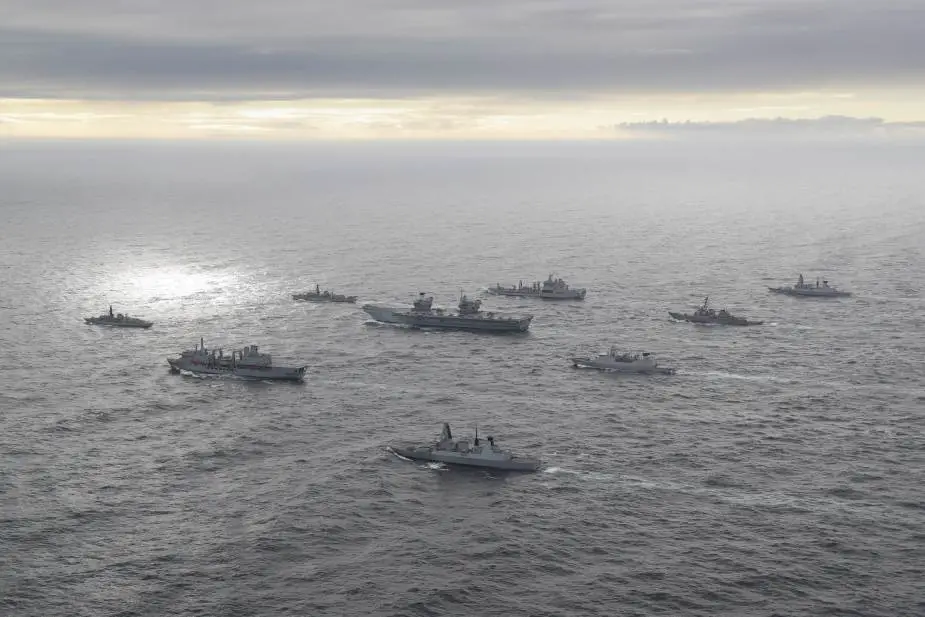Breaking news
US and British navies to deploy joint Carrier Strike Group 2021 led by HMS Queen Elizabeth aircraft carrier.
According to a statement released by the U.S. Department of Defense on January 19, 2021, Acting U.S. Secretary of Defense Christopher C. Miller and UK Secretary of State for Defense Ben Wallace have co-signed the Joint Declaration for the Carrier Strike Group 2021 deployment, led by the British Navy aircraft carrier, HMS Queen Elizabeth.
Follow Navy Recognition on Google News at this link
 The British Navy HMS Queen Elizabeth carrier strike group. (Picture source British Navy)
The British Navy HMS Queen Elizabeth carrier strike group. (Picture source British Navy)
A carrier strike group (CSG) is a type of Naval carrier battle group of the United States Navy. It is an operational formation composed of roughly 7,500 personnel, usually an aircraft carrier, at least one cruiser, a destroyer squadron of at least two destroyers or frigates.
The Joint Declaration enables the deployment of U.S. Marine Corps and U.S. Navy personnel and equipment, including a detachment of U.S. Marine Corps F-35B Lightning II aircraft and the Navy’s USS The Sullivans (DDG-68), as part of a UK-U.S. combined carrier strike group, led by the British Navy aircraft carrier, HMS Queen Elizabeth.
This deployment underscores the strength of our bilateral ties and demonstrates U.S.-UK interoperability, both of which are key tenets of the U.S. National Defense Strategy. The leaders look forward to seeing the culmination of nearly a decade of U.S.-UK carrier cooperation when Carrier Strike Group 2021 sets sail from Portsmouth, UK later this year.
The UK reached a major milestone in December when it declared its Carrier Strike program had achieved Initial Operating Capability following a series of multi-national exercises throughout 2020. This Joint Declaration paves the way for a successful inaugural operational deployment of the UK Carrier Strike Group alongside its allies.
According to naval military sources, a typical British Navy Carrier Strike Group will include the Queen Elizabeth-class aircraft carrier, two surface escorts, with Type 23 frigate for anti-submarine warfare and/or Type 45 destroyer for anti-air warfare), a submarine, and a fleet tanker. In the future, escort duties will also be provided by the Royal Navy's new Type 26 frigate. For replenishment-at-sea, the Royal Fleet Auxiliary provides its Tide-class fleet tankers, which were specially designed to refuel the aircraft carriers, in addition to RFA Fort Victoria for dry stores.
The HMS Queen Elizabeth is the lead ship of the two Queen Elizabeth-class aircraft carriers in service with the British Navy. The ship was launched on 21 December 2017, and was commissioned on 10 December 2019. She has an overall length of 280 meters (920 ft), a width at deck level of 70 meters (230 ft), a height of 56 meters (184 ft), a draught of 11 meters (36 ft), and a range of 10,000 nautical miles (12,000 mi; 19,000 km).
The propulsion of the HMS Queen Elizabeth consists of two Rolls-Royce Marine Trent MT30 36 MW (48,000 hp) gas turbine engine and four Wärtsilä 38 marine diesel engines. The ship can reach a top speed of 25 knots (46 km/h; 29 mph). The ship has a crew of 679 people that not include the air elements. for its self-protection, the aircraft carrier is armed with three Phalanx CIWS (Close-In Weapon Systems), four 30-mm DS30M Mk2 automatic cannons, and six Miniguns.
The HMS Queen Elizabeth is deployed with up to two operational Lightning fighter aircraft squadrons with a maximum of 24 F-35Bs short takeoff/vertical landing (STOVL) fighter aircraft and the ability to operate 36 F-35B in extreme circumstances. Fourteen Merlin HM2 will be available with typically nine in anti-submarine configuration and four or five with Crowsnest for airborne early warning.
The USS The Sullivans (DDG-68), is an Arleigh Burke-class Flight I Aegis guided missile destroyer in service with the U.S. Navy. The ship is designed as a multimission destroyer, able to fulfill the strategic land strike role with Tomahawk missiles; antiaircraft warfare (AAW) role with powerful Aegis radar and surface-to-air missiles; antisubmarine warfare (ASW) with towed sonar array, anti-submarine rockets, and ASW helicopter; and antisurface warfare (ASuW) with Harpoon missile launcher.


























